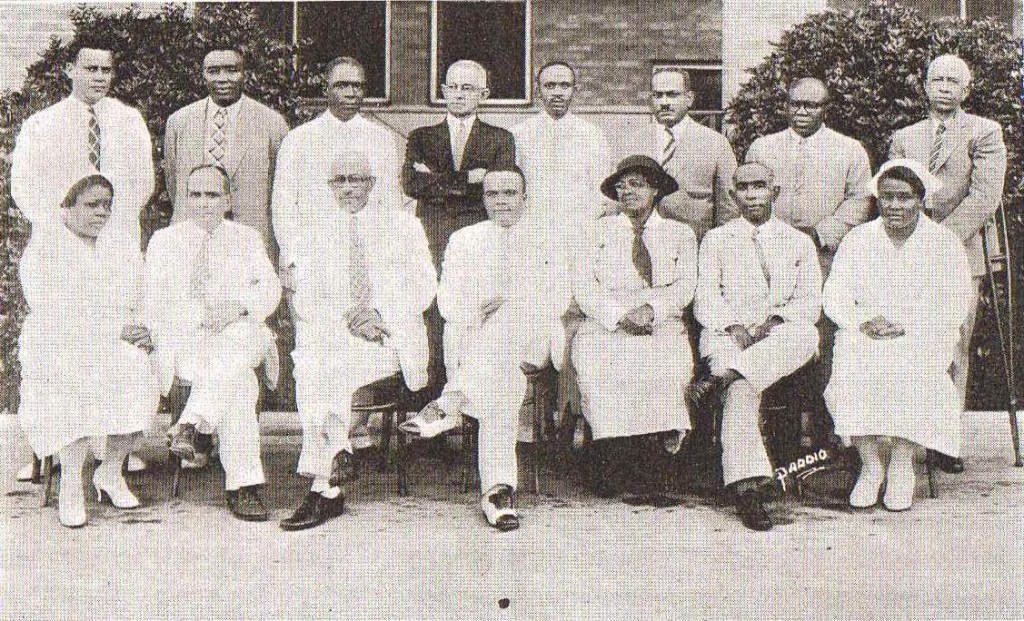Left to right. seated – Miss Eola V. Lyons, R.N. (Chairman on Arrangements for Nurses); Bishop Robert Elijah Jones; Rivers Frederick, M.D., (General Chairman); Clarence Clement Haydel, M.D., (Chairman, Executive Committee); Mrs. Estelle Hubbard, R.N., Benjamin Franklin Easter, M.D., Miss Viola J. Reed, R.N. Standing– Albert Walker Dent., George Bracy Talbert, D.D.S., Armand V. Boutte, Ph.D., Thaddeus Taylor, M.D., William R. Adams, M.D., Rubie Justin Vining, M.D., Aaron Walter Brazier, M.D., William Elliot Weeks, M.D.
In a previous post, we highlighted the Housing Committee which busily prepared for the National Medical Association Convention held in New Orleans in 1935. It is important to note that this was only one committee of many formed to make the conference a success. The individuals shown above were the local members who were assigned to spearhead all aspects of this conference.
As August 11, 1935 approached, hundreds of the most outstanding black surgeons, physicians, dentists, and pharmacists from all sections of the United States arrived in the city and completed registration prior to its opening session. Nearly every year since its founding in 1895, the N.M.A. had held an annual convention which was regarded as the nation’s foremost forum on medical science and African American health. From 1910 to 1940, the American Medical Association was the nation’s main medical association, but numerous black doctors were unable to join the A.M.A due to the lack of county medical societies and because of local bigoted practices which limited the number of African American members. For these reasons, the N.M.A was needed to fill that void.
All of New Orleans looked forward with keen anticipation to its coming. It was such a big event that The Louisiana Weekly ran several articles weeks in advance on the various sessions that would be taking place. Many topics were geared toward improving the quality of health among minorities and disadvantaged people. Several of the topics to be discussed were: “Hospitalization for the Tuberculosis Negro,” “Need of Hospitals for Negro Physicians,” and “Significance of Bi-Racial Staffs in Negro Hospitals.” In addition to the many medical sessions, special clinics were held for those whose income was less than seventy-five dollars. A fee of twenty-five cents was charged each clinic patient. These clinicsand Touro Hospitals were held at Charity, Flint-Goodridge .
Of course, no one can come to New Orleans and leave without having a good time, so the Women’s Auxiliary of Flint-Goodridge Hospital and a committee of more than a hundred others, aided the doctors in planning various forms of entertainment for the visitors. A tea on the lawn of Flint-Goodridge was on the schedule of events along with a bridge party given on the Pythian Temple Roof Garden. The crowning event was the monster subscription dance on Wednesday night, August 14, also on the Roof Garden. Beach and bathing parties, sightseeing trips, and many smaller events were planned also. The local ladies of New Orleans were already purchasing new frocks. Many homes were being opened to the visitors, and things in general pointed toward a successful session. From a social point of view, New Orleans was ready to live up to its reputation.
Sources: The Louisiana Weekly, 3 August, 10 August, 24 August 1935; National Medical Association website – www.nmanet.org.
Lolita V. Cherrie




I have really enjoyed your blog and have sent it on to many others. Can you please tell me where to find the location of the Pythian Temple that was mentioned in this article. Of course, I realize that it may not exist anymore, but would like to know the address at that time period. My father (Dr. Charles B. Wickham) was the head (Supreme Councilor) of the Pythians at that time.
I look forward to your future blogs.
The building is still standing at 234 Loyola Avenue in the Central Business District. Prior to Hurricane Katrina, it contained several office suites, including one belonging to the Orleans Parish Clerk of Court. It is now empty and not used for any particular purpose. Thank you so much for visiting our blog and please share it with others!
Hello, you have several people of interest that once lived in the Parish of Terrebonne. I was wondering how I can obtain a picture of Eula V. Lyons, Benjamin F. Easter, and John Brown. Thanks, Margie Scoby
mscoby@ymail.com
Bonjour Ms. Wickham! Following the Civil War, American men felt an increasing need for fraternal organizations, thus the Knights of Pythias of the World were formed in 1864. Within the African-American community, Prince Hall Masonry had spread like its nearly exclusively white counterparts since the 1790s. Two of the largest national fraternal orders, the Benevolent and Protective Order of the Elks and the Knights of Pythias, both denied membership to men of color. Due to the admission of several fair-skinned black Mississippians who were able to acquire Pythian secrets and rituals, the Knights of Pythias of North America, South America, Europe, Asia, Africa, and Australia (the Colored Knights of Pythias) were founded in 1880, led by Thomas W. Stringer. Likewise, independent black groups of Elks and Odd Fellows were formed as well. Dr. Charles B. Wickham served as Grand Chancellor of Oklahoma (head of the Order in the state). He also served as Supreme Vice Chancellor (second highest-ranking national officer) under Smith Wendell Green, who served as Supreme Chancellor. The New Orleans Temple was built in 1908 and the imposing Temple in Chicago, the largest in the country, was built in 1928. Dr. Wickham also served as Supreme Worthy Counselor to the Court of Calanthe, which was the auxiliary body of the Pythians for women. Thank you for visiting the blog and please share with others!
Dr. Adams was my father.